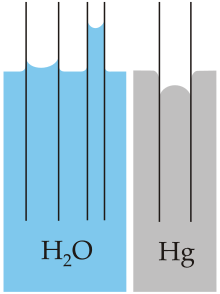
Jurin's law, or capillary rise, is the simplest analysis of capillary action—the induced motion of liquids in small channels[1]—and states that the maximum height of a liquid in a capillary tube is inversely proportional to the tube's diameter. Capillary action is one of the most common fluid mechanical effects explored in the field of microfluidics. Jurin's law is named after James Jurin, who discovered it between 1718 and 1719.[2] His quantitative law suggests that the maximum height of liquid in a capillary tube is inversely proportional to the tube's diameter. The difference in height between the surroundings of the tube and the inside, as well as the shape of the meniscus, are caused by capillary action. The mathematical expression of this law can be derived directly from hydrostatic principles and the Young–Laplace equation. Jurin's law allows the measurement of the surface tension of a liquid and can be used to derive the capillary length.[3]
- ^ Rapp, E., Bastian (13 December 2016). Microfluidics : modeling, mechanics and mathematics. Kidlington, Oxford, United Kingdom. ISBN 9781455731510. OCLC 966685733.
{{cite book}}: CS1 maint: location missing publisher (link) CS1 maint: multiple names: authors list (link) - ^ See:
- James Jurin (1718) "An account of some experiments shown before the Royal Society; with an enquiry into the cause of some of the ascent and suspension of water in capillary tubes," Philosophical Transactions of the Royal Society of London, 30 : 739–747.
- James Jurin (1719) "An account of some new experiments, relating to the action of glass tubes upon water and quicksilver," Philosophical Transactions of the Royal Society of London, 30 : 1083–1096.
- ^ Quéré, David; Brochard-Wyart, Françoise; Gennes, Pierre-Gilles de (2004), "Capillarity and Gravity", Capillarity and Wetting Phenomena, Springer, New York, NY, pp. 33–67, doi:10.1007/978-0-387-21656-0_2, ISBN 9781441918338